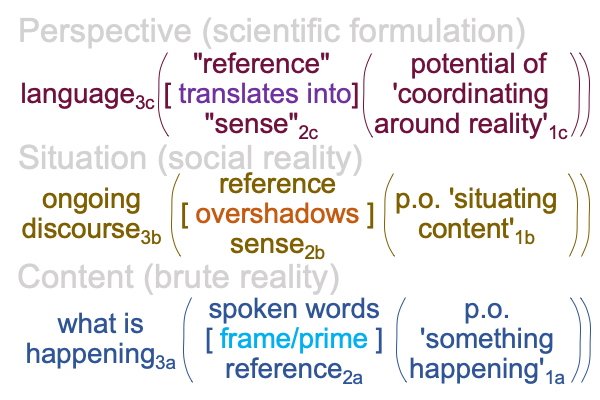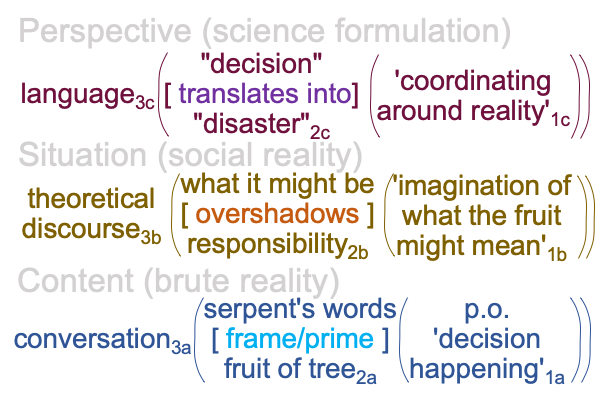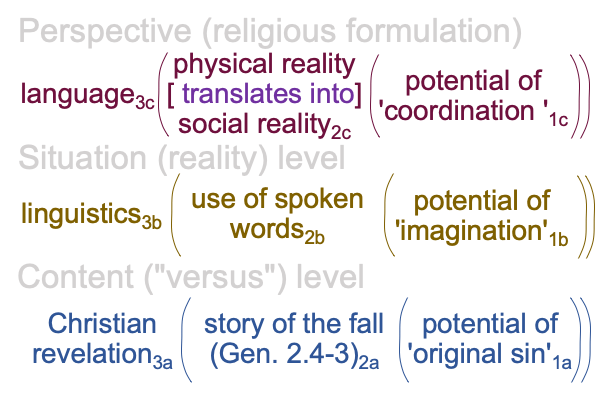0973 How is that for a Gestalt switch?
But now, I walk the soggy ground of theology and scientists wriggle in their seats.
0974 Here are my claims.
The story in Genesis 2.4 through Genesis 3 may be regarded as a fairy tale about the way that speech-alone talk potentiates unconstrained social complexity, by changing the character of both language and reality.
Furthermore, I submit that this fairy tale unlocks the background of Enfield’s scientific treatise.
In order to demonstrate these two points, I must conjure an alternate Gestalt for Enfield’s interscope.
That means… an alternate interscope… to the scientific?
0975 I begin by associating the story of the temptation of Eve and the subsequent Fall with Enfield’s interscope.
Here is the starting location.

Behold.
There, in the center of the garden of Eden, stands the tree of the knowledge of good and evil. Eve is attracted to it, because she sees animals and birds eating the fruit, with no ill effect. However, she knows that God told Adam not to eat of it, for on that day he will die. So, why would the fruit be fatal for Adam and her, but not fatal to the birds and the squirrels who eat of it?
The serpent, a creature who has no hands or arms and therefore, is incapable of hand talk, replies to her query. They begin a conversation, in speech-alone talk.
0976 The serpent’s words frame the conversation3a in terms of making a decision whether to eat the fruit or not1a. As soon as the serpent frames the possibility of making a decision1a, Eve is primed to imagine what the fruit might mean1b. If it does not mean poison, then what?
The serpent’s suggestions as to what the fruit might mean1b, given God’s command not to eat of it1a, soon overshadows her sensibility that the fruit is poisonous2b along with her responsibility to keep God’s command2b. The serpent’s use of words3b characterizes theoretical discourse3b, such as the specialized discourses that build models in linguistics and cognitive psychology3b.
0977 Indeed, the way that Eve refers to the fruit of the tree of the knowledge of good and evil2a changes. Her increasing sense of curiosity1b and diminishing sense of responsibility2b, generates a potential of coordinating around the reality of God’s command1c, by getting Adam involved, not with her decision as much as her commitment to make a decision2c.
Of course, Adam eats the fruit in an act of solidarity with the one he loves.
0978 Here is a picture of the story, entered into Enfield’s interscope.

0980 Can I feel a Gestalt shift?
Does the above interscope speak to the religion side of an audience in a religion-science conference?
After all, all I have done is place elements of the Adam and Eve story into slots for Enfield’s interscope.
Plus, the associations seem to be appropriate.
0981 Now, I want to compare the two interscopes, level by level, and discern another (background) interscope. In order to do so, I look through the science interscope at the interscope with the Adam and Eve stories. Then, I look through the religion interscope at the science side, and voila. The background interscope becomes more and more apparent.
I start with the perspective level from the side of science.
How does language3c coordinate reality1c?
I suppose that the actuality2c goes with a literal rendition of the Adam and Eve interscope.
The normal context of spoken language3c brings the actuality of a decision [translating into] disaster2c into relation with the possibility of coordinating around the reality of God’s command1c.
What about the view from the religion side looking to the science side?
I guess that what I see is not quite literal, and not quite allegorical, and well, more like a voice that Enfield may agree with, while at the same time, disagree with.
The normal context of language3c brings the actuality of physical reality (eating the fruit) [translating into] social reality(the recognition that they are naked)2c into relation with the potential that ‘coordination may constitute rebellion against God’1c.
0982 Next is the science side’s rendition of the Adam and Eves side for the situation level.
The normal context of theoretical discourse3b brings the actuality of speculation on what the fruit might be [overshadowing] Eve’s sensibility and responsibility2b in regards to the potential of ‘imagining what the fruit might mean’1b.
I move into the rendition through the religion side.
The normal context of linguistics and cognitive psychology3b brings the actualities of the use of spoken words2b into relation with the potential of ‘imagination’1b.
Now, something in the background seems to be moving towards the foreground. An inversion constellates.
Why?
The religious side puts linguistic and cognitive psychology into the situation level, implying a recognition of the limitations of scientific inquiry. Language3c puts linguistics3b into perspective.
0983 Next is the science point of view of the Adam and Eve fill-in on the content level.
The normal context of a conversation (between the serpent and Eve)3a brings the actuality of the serpent’s words [framing] the fruit of the tree of good and evil2a into relation to the potential of ‘Eve making a decision’1a.
The corresponding religious view-through on the content level brings in parties that are not cognitive psychologists or linguists. These parties stand in the background of an initial implicit abstraction, that is invisible to Enfield’s inquiry.
The normal context of Christian revelation3a brings the actuality of the story of the fall in Genesis2a into relation with the potential of ‘the doctrine of original sin’1a.
0984 What have I accomplished?
Well, I suppose I have brought an interscope in the background into the foreground.
The explicit distinction that grounds Enfield’s work is viewed from the cloud of implicit abstraction. The stories of Adam and Eve enter into the “body” of Enfield’s interscope, giving rise to two constellations (roughly) corresponding to Enfield’s grounding distinction. One rendition plays out as a literal or “physical” association of the stories to elements in Enfield’s interscope. The other rendition yields a more-comprehensive or “social” association of what the stories tell us about our current Lebenswelt.
The first rendition consists of Enfield’s interscope.
This second rendition constitutes an inversion of the first.

Weirdly, the ground beneath my feet is no longer so mushy and some scientists are leaving the auditorium.
Others remain.
